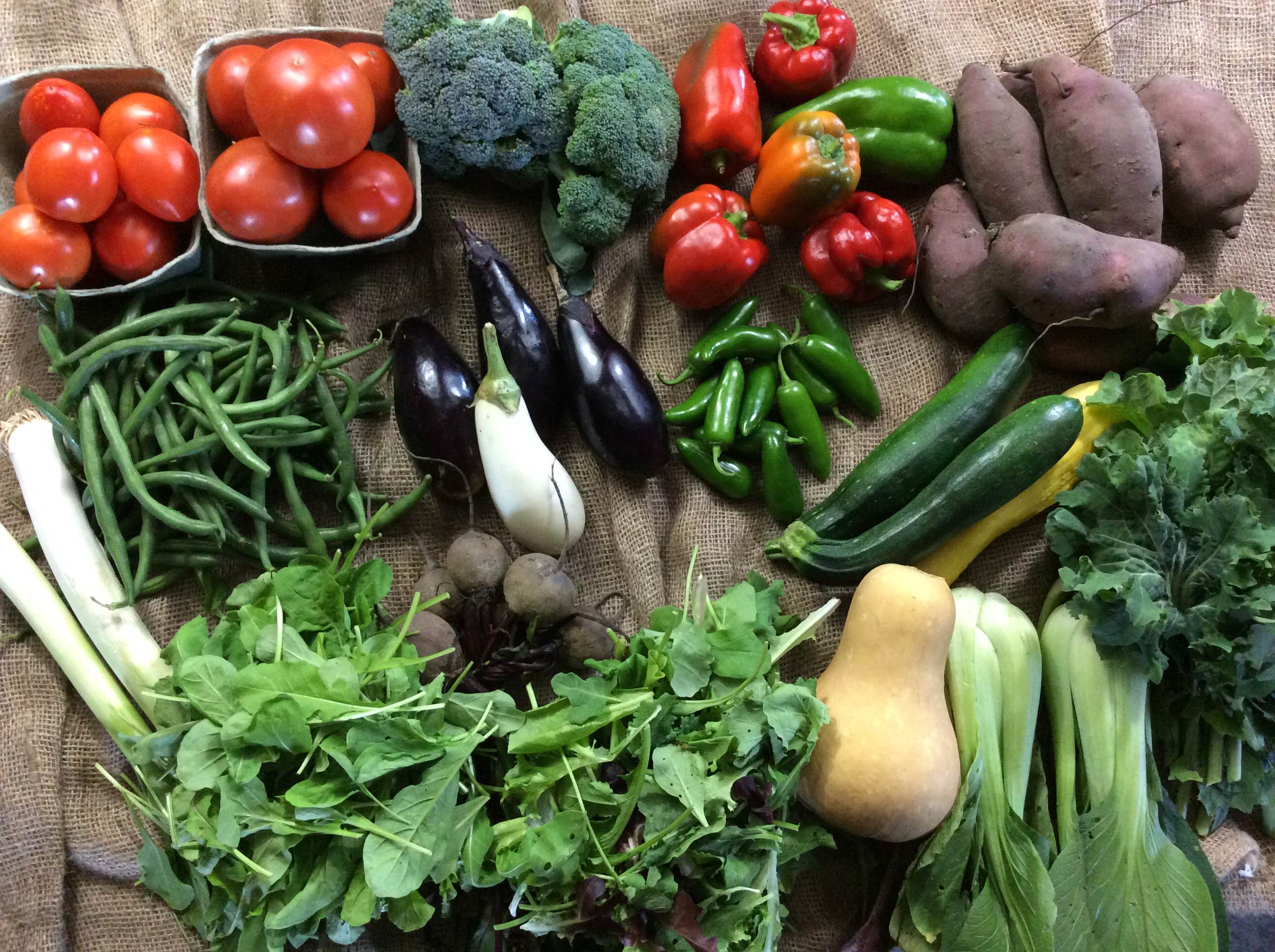Well, we’ve been paying attention to your responses and various conversations with you over the past season and we have some modifications we’d like to try out with you this week. The main thing we’ve heard from you is that you’d like more control over the items you receive. Some people love beets, but most don’t. You don’t want to throw things away, and we don’t want to grow crops that go to waste. We’ve come up with a concept for next season that will pretty much involve complete freedom to choose whatever items you want (Think farmer’s market booth right here at the farm). We’ll need your input on what types of crops you prefer so we can get good sense of the planting space required for each item but I think we can work something out.
This week we are going to try somewhat of a hybrid between this season’s model and what we are suggesting for next year. Everyone will receive 4 core items with Large Shares getting 2x the amount of each item. Then we will have 10 additional items available for you to choose from. Small Shares will choose 3 different items and Large Shares choose 6 items.
Week 19 of the Redfearn CSA includes (on the photo top to bottom, left to right, showing all of the core items on the top row and the choice item on the second and third rows):
Core items: Tomatoes, Sweet Peppers, Broccoli, Sweet Potatoes
Choice items (Small Shares will choose 3 different items and Large Shares choose 6 items): Leeks, Green Beans, Eggplant, Spicy Peppers, Zucchini/ Yellow Squash, Kale (Russian), Arugula, Beets, Salad Mix, Butternut Squash, and Bok Choy
Core Items:
Tomatoes: Store at room temperature, NOT in a plastic bag.
Sweet peppers: Store in plastic bag, in refrigerator. Meal idea: sauté sliced candy onions and sweet pepper for a tasty Philly Cheese Sandwich or Fajitas. Stuffed peppers are also a favorite main dish at our house; zucchini/ yellow squash can also be stuffed using the same recipe. Sweet peppers can easily be preserved by freezing and they can be frozen raw, without blanching first. Cut peppers into the desired size: diced for adding to winter casseroles, soups or sauces; sliced for fajitas; or halved (or the tops cut off) to be used for stuffed peppers (also, after freezing there is no need to parboil peppers before stuffing) and freeze in freezer bags.
Broccoli: Store in a loose plastic bag in the refrigerator. Peeling the stems with a pairing knife is a great way to make the stems more tender. Here’s a couple of recipe ideas: Broccoli Salad and Roasted Broccoli. Broccoli can be paired with leeks as in this Potato, Leek and Broccoli Soup.
Sweet Potatoes: Store at room temperature. Here is a compilation of Sweet Potato Recipes, to give you some ides. For a savory sweet potato dish try this: Curried Lentils and Sweet Potatoes (Excellent).
CHOICES (small shares choose 3 different items, large shares 6 items):
Green beans: store in plastic bag in refrigerator. Basic cooking instructions: trim the stem end off and leave beans whole or snap into shorter pieces. Heat a pot of salted water to boiling, add beans, and boil 2 to 4 minutes, until almost tender- crisp. Drain beans very well (if you will be finishing the beans later, cool the bean beans to prevent further cooking, beans can also be frozen at this point). Heat butter and olive oil in a skillet (about 1 T each, can be increased or decreased to taste) over medium heat, add beans and salt and pepper to taste, and stir until tender, toward the end of cooking add 1 or 2 cloves garlic (chopped) if desired. Additions: crumbled bacon, toasted slivered almonds, stirred into the beans after cooking. Also, these Roasted Green Beans are great.
Eggplant: Store in plastic bag in the refrigerator, but use quickly, because eggplant doesn’t store well. The best tip I have for tasty eggplant is to salt and drain the prepared (sliced, cubed, etc) eggplant for at least 20-30 minutes before cooking (this takes away any bitterness and also, helps the eggplant to absorb less oil during cooking). Here’s a page with detailed instructions about eggplant preparation and recipes: Fine Cooking: How to cook Eggplant. Eggplant can be sauteed, grilled or roasted. It is great combined with zucchini and tomatoes (such as in Ratatouille). For eggplant recipes from Italy to China, check out these: Global Eggplant Recipes. A wonderful eggplant recipe (and one that doesn’t require salting and draining the eggplant) is Smitten Kitchen’s Eggplant Bruschetta (which has a Mediterranean style topping). Moussaka is a greek dish with eggplant. Here is a relatively simple recipe for Moussaka recommended by a CSA member (and also tried and deliciously approved by the Redfearn family).
Spicy peppers: Store in plastic bag, in refrigerator. The spicy peppers are abundant this Chop and add to salsa, or use in this Jalapeno Popper Chicken. If you want to try water-bath canning, try this Jalapeno Jelly (I’ve used a combination of peppers). Anaheim and poblano peppers can be stuffed, as in these Chicken and Cheese Stuffed Anaheim Peppers, or Black beans and Cheese stuffed Poblano Peppers, or Rice and Beef stuffed Peppers. Peppers can be frozen; slice or dice and then place in freezer bags, can be used in fajitas, or anywhere you would use cooked peppers (after thawing the peppers are soft).
Salad mix: Store in plastic bag in the refrigerator. Wash before eating, and dry well. Lettuce (torn into bite-sized pieces) and combined with some of the arugula, makes for a salad mix similar to last week’s salad mix. For salad inspiration, look at this:Mesclun Salad with goat cheese, or Chart of Salad Toppings Combinations.
Zucchini/ summer squash: store in plastic bag in refrigerator. Zucchini is great raw or sautéed, grilled, or baked into zucchini bread (my kids favorite way to eat zucchini!). Raw zucchini/ squash makes a fresh, flavorful salad as in this: Summer Squash Salad with Lemon Citronette. Zucchini (sliced and broiled or pan fried) can take the place of pasta in lasagna. If you want more ideas, you can try Baked Zucchini Fries, Squash baked eggs or Zucchini Fritters or Chocolate Zucchini Bread or these main dishes Baked Penne with Roasted Vegetables (this is a great recipe to use a lot of vegetables, including zucchini, yellow squash, eggplant, peppers, onions and garlic), Cheesy Zucchini Casserole (which we make with shredded sharp cheddar, instead of Velvetta). Here’s a couple other zucchini recipes, recommended by CSA members: Curried Zucchini Soup, Zucchini Tots, Sauteed Zucchini with Cherry Tomatoes (don’t overcook the zucchini!), and Zucchini Chocolate Rum Cake. To preserve: Zucchini or Yellow squash can be shredded and frozen to use in Zucchini bread recipes.
Leeks: store in plastic bag in refrigerator. Leeks are a kind of onion and can be used in many recipes (quiches, tarts, soups) interchangeably with onions. Here is a recipe for Leek Potato Soup . Typically the white and light green sections are used, but the dark green leaf portions can be used to season vegetable or chicken stock. Leeks need to be washed well, since dirt can get in between the layers.
Beets: Store in plastic bag in the refrigerator. Both the roots and leaves are great. Here is a compilation of recipes: Huffington Post Beet Recipes (we have enjoyed recipe #4, French Peasant Beets). Beets make a great addition to salad, as in this Roasted Beet Salad with Pea Shoots and Beet salad with Goat Cheese .
Arugula: store in plastic bag in refrigerator. This slightly spicy salad green is wonderful in this Roasted Sweet Potato Arugula Salad! Arugula is also wonderful topped with thinly sliced steak, as in this: Skirt Steak Salad with Arugula and Blue Cheese. Combine arugula with pasta in this Goat Cheese and Arugula over Penne dish. Arugula can also be sautéed in olive oil with some garlic just until wilted. Arugula is great in this Arugula Soup that our whole family enjoys (2 onions can be substituted for the 6 shallots in the recipe, larger potatoes can be used instead of the salad potatoes). Some other ideas are listed in this: Top 5 Uses for Arugula Besides Salad.
Bok Choy: Store in plastic bag in the refrigerator. Here is a basic bok choy recipe with great instructions: Stir-fried Bok Choy. Cooked (leftover) Bok Choy can be added to fried rice. Bok Choy can also be cooked and used inside egg rolls (I just followed the instructions on the back of the package of egg roll wrappers). Bok choy can be sliced and added to soups during the last few minutes of cooking.If you would rather eat bok choy raw; it can be chopped and dressed with an asian- style dressing: Bok Choy Salad.
Kale: store in plastic bag in refrigerator. Baby Kale is great in Kale salad or in any kale dish, but it doesn’t need as much time to cook. Try this Zuppa Tuscana soup (I usually add a can of tomatoes to this soup and sometimes kidney beans). Or, try this method of fixing kale:
Kale, Sausage and Beans
8 to 16 oz. smoked sausage (or omit and increase beans, for a vegetarian version), sliced
1 Onion, chopped
3 (or more) cloves garlic, finally chopped
1 can (or about 2 cups, peeled) tomatoes, with liquid
Kale, 7- 10 leaves, removed from stem and chopped (with Baby kale, add a couple l handfuls of kale leaves, chopped)
1 can drained (or about 2 Cups, cooked) white beans, like great northern or cannellini beans
Brown the sausage in a skillet and then remove sausage to a paper towel lined plate and drain off excess oil. Saute the onions in olive oil over medium heat, till soft and golden, 5- 10 minutes. Add chopped garlic and kale, stir to begin to wilt. Then add tomatoes and cover: lower heat and cook until kale is tender, about 5 to 7 minutes, stirring occasionally. Stir in beans and sausage and season to taste (red pepper flakes are a good addition). Can be topped with shredded parmesan cheese.

